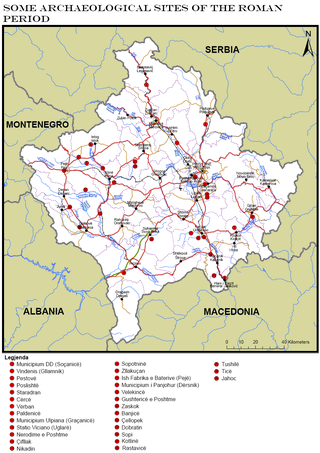Top Qs
Timeline
Chat
Perspective
Roman heritage in Kosovo
Historical Roman influence in Kosovo From Wikipedia, the free encyclopedia
Remove ads
The Roman heritage sites in Kosovo represent a multitude of monuments of material and spiritual culture, which reflect the Roman period in this region.[1] Among them, a special place is occupied by those that represent the development of art, such as the plastic monuments that are more frequent, and at the same time occupy an important place, because with the presentation of figures in relief and with numerous inscriptions they speak to us enough for this period.[2]

Remove ads
Overview
Summarize
Perspective
Dardania fell under Roman occupation in the first century AD, one of the last territories of Illyria to succumb. Being that Dardania had and today Kosovo has a central position between the road networks that connected the south Aegean with the Danube basin, and with the Adriatic Sea, it was a strategic jewel. It also was important for the Romans due to its rich mineral resources, which they exploited and benefited from. We see that most of the towns of ancient Dardania are located either close to a mine, or close to a road. The Dardanian identity has been disputed for a while, and it is known that it was distinctive, similar to the Illyrian, and also with a Roman or Thracian twist to it, due to the occupation and co-habitation. The archaeological surveys and studies of the last century are helping to establish this Dardanian identity in an objective manner, which will lead to a clearer study and explanation of the continuity of culture in this so much disputed region. Below is a listing of the prominent settlements during the Roman period and an explanation of what they were, when they were inhabited, and when they were founded, accompanied by an array of pictures that illustrate the archaeological finds and remnants.[3]
Municipium Dardanorum

Municipium Dardanorum[3] or Dardanicum[4] is located in North Kosovo, approximately 27 kilometres north of Mitrovica, in the village of Sočanica, Leposavic municipality. It existed as a prehistoric settlement at first, but continued to develop and change to become a typical ancient Roman town during the period from the last decades of the 1st century, until the first part of the 4th century AD. The site stretches in approximately 30 hectares.[3][5][6][7]
Ulpiana

Ulpiana was a Roman town, established in the 1st century AD, receiving municipium status in 169 AD.
Vendenis
Statio Vindenis was among three road stations that were constructed in Dardania during Roman rule.[5][8]
Çifllak archaeological site
Çifllak site is situated near the Drini i Bardhë river stream, on the left side.[9][10]
Dresnik archaeological site
The Archaeological Site of Dresnik is an archaeological site in the village of Dresnik.[11]
Kllokot archaeological site
The site of Klokot is located close to Banja e Kllokotit.[5]
Nerodime e Poshtme
Nerodimë e Poshtme site, uncovered in 1988.[9]
Nikadin archaeological site

Nikadin. The Nikadin village, located in the town of Ferizaj, is situated 2 kilometers south from the town.[9][12]
Pestova archaeological site

The site of Pestova is located in the municipality of Vushtrri, discovered in 2005. Remains of a building, ruins of a villae rusticae were partially unearthed.[5]
Poslishte archaeological site
The site of Poslishte is a recently discovered Roman road junction in the vicinity of the village of Poslishtë, 1 kilometer south of Vlashnjë in the Vërmica-Prizren road, set along the ancient Via Lissus-Naissus.[5]
Paldenica archaeological site
The site of Paldenica located near the village of Paldenica, around 150 m on the left side of the Pristina-Skopje road. Traces of a necropolis and other movable archaeological materials have been uncovered.[5]
Vicianum
Station Viciano situated in the northwest part of the municipality of Gračanica.[9]
Remove ads
See also
References
Bibliography
Wikiwand - on
Seamless Wikipedia browsing. On steroids.
Remove ads
